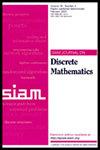随机项链所需的剪裁更少
IF 0.9
3区 数学
Q2 MATHEMATICS
引用次数: 0
摘要
SIAM 离散数学杂志》,第 38 卷第 2 期,第 1381-1408 页,2024 年 6 月。摘要已知任何有[math]类型珠子的开放项链,其中每种类型珠子的数量都能被[math]整除,可以用至多[math]个切割分割成[math]集合的区间,每个区间包含每种类型相同数量的珠子。这对所有 [math] 和 [math] 值都是严密的。在这里,我们考虑随机项链的情况,即每种类型的珠子数量为 [math]。那么,具有上述性质的 "公平 "分割所需的最小切割次数就是一个随机变量 [math]。我们证明,对于固定的[math]和较大的[math],这个随机变量至少是[math],而且概率很高。对于[math]、固定[math]和大[math],我们确定了[math]在所有[math]值下的概率渐近行为。我们证明,当[math]时,这个概率是多项式小概率;当[math]时,这个概率离零有界;当[math]时,这个概率像[math]一样衰减。我们还证明,对于较大的 [math],[math] 最有可能是 [math],而对于较大的 [math]和较大比率的 [math],[math] 极有可能是 [math]。本文章由计算机程序翻译,如有差异,请以英文原文为准。
Random Necklaces Require Fewer Cuts
SIAM Journal on Discrete Mathematics, Volume 38, Issue 2, Page 1381-1408, June 2024.
Abstract. It is known that any open necklace with beads of [math] types, in which the number of beads of each type is divisible by [math], can be partitioned by at most [math] cuts into intervals that can be distributed into [math] collections, each containing the same number of beads of each type. This is tight for all values of [math] and [math]. Here, we consider the case of random necklaces, where the number of beads of each type is [math]. Then the minimum number of cuts required for a “fair” partition with the above property is a random variable [math]. We prove that for fixed [math] and large [math], this random variable is at least [math] with high probability. For [math], fixed [math], and large [math], we determine the asymptotic behavior of the probability that [math] for all values of [math]. We show that this probability is polynomially small when [math], is bounded away from zero when [math], and decays like [math] when [math]. We also show that for large [math], [math] is at most [math] with high probability and that for large [math] and large ratio [math], [math] is [math] with high probability.
Abstract. It is known that any open necklace with beads of [math] types, in which the number of beads of each type is divisible by [math], can be partitioned by at most [math] cuts into intervals that can be distributed into [math] collections, each containing the same number of beads of each type. This is tight for all values of [math] and [math]. Here, we consider the case of random necklaces, where the number of beads of each type is [math]. Then the minimum number of cuts required for a “fair” partition with the above property is a random variable [math]. We prove that for fixed [math] and large [math], this random variable is at least [math] with high probability. For [math], fixed [math], and large [math], we determine the asymptotic behavior of the probability that [math] for all values of [math]. We show that this probability is polynomially small when [math], is bounded away from zero when [math], and decays like [math] when [math]. We also show that for large [math], [math] is at most [math] with high probability and that for large [math] and large ratio [math], [math] is [math] with high probability.
求助全文
通过发布文献求助,成功后即可免费获取论文全文。
去求助
来源期刊
CiteScore
1.90
自引率
0.00%
发文量
124
审稿时长
4-8 weeks
期刊介绍:
SIAM Journal on Discrete Mathematics (SIDMA) publishes research papers of exceptional quality in pure and applied discrete mathematics, broadly interpreted. The journal''s focus is primarily theoretical rather than empirical, but the editors welcome papers that evolve from or have potential application to real-world problems. Submissions must be clearly written and make a significant contribution.
Topics include but are not limited to:
properties of and extremal problems for discrete structures
combinatorial optimization, including approximation algorithms
algebraic and enumerative combinatorics
coding and information theory
additive, analytic combinatorics and number theory
combinatorial matrix theory and spectral graph theory
design and analysis of algorithms for discrete structures
discrete problems in computational complexity
discrete and computational geometry
discrete methods in computational biology, and bioinformatics
probabilistic methods and randomized algorithms.

 求助内容:
求助内容: 应助结果提醒方式:
应助结果提醒方式:


